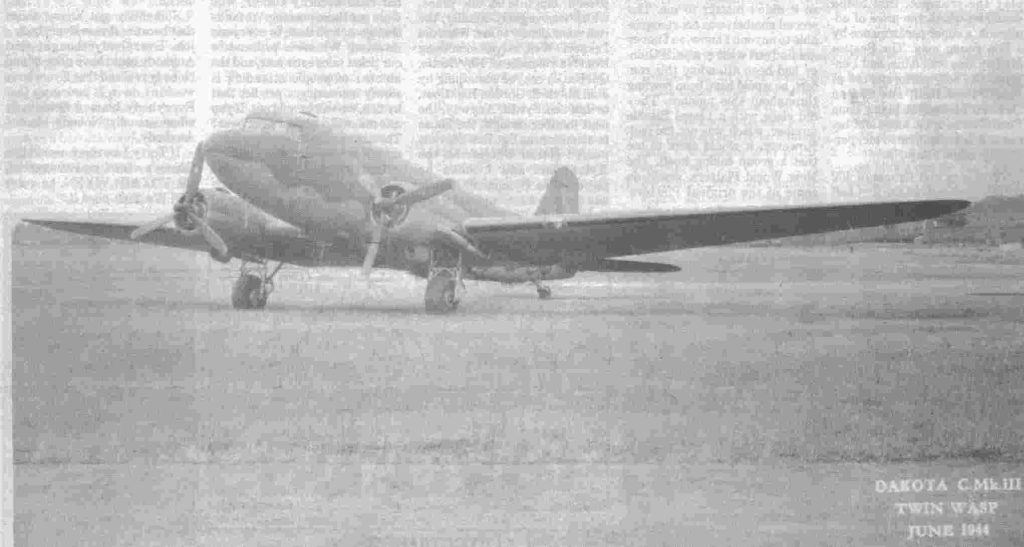(reprinted from the 22 March 1989 issue of The Voxair)

The Dakota Mark III as it was flown in England in 1944. – Le Dakota Mark III faisait partie des Forces canadiennes outre-mer en 1944
Flew in Burma
by Maj. Robert Butt
Four of the Dakota aircraft that will retire from RCAF and OF service in March 1989, didn’t start their operational lives with the RCAF. In fact, they started with the RAF and were later returned to the RCAF after service with Canadian squadrons overseas.
The first of these is tail number 12963, the 48th Dakota to see service with the Canadian military and one of two still in service that flew in Burma.
Built at the Douglas Oklahoma City plant in 1942, this aircraft was delivered by the US Army Air Force in January 1944, transferred to the RAF, accepted in Montreal on 27 January as 42-92419 and flown to Britain in February. The Mark II was given the British number FZ 658, handed to 512 Squadron at RAF Station Hendon and then moved with it to RAF Station Broadwell on 14 February.
Eight months later, it was transferred to 48 Squadron at Down Ampney, Gioucestershire, and moved with the squadron to Patanga, India, in August 1945. In September, it went to work with the Canadian 435 and 436 Squadrons at Tulihal and Manipur in India, returning with 485 Squadron to Down Ampney at the end of the month.
The aircraft stayed in Down Ampney until taken over by the RCAF on 26 August 1946. It was assigned tail number 992 and returned to Canada.
After a series of storages and some service at repair depots and technical service units in Weyburn, Sask., and Trenton, Ont., the aircraft went back to work at RCAF Station Summerside in 1961. In 1952, it was modified to a Mark ITIN and returned to service at 1 Air Navigation School in Summerside. In 1953, long term storage was commenced at Trenton and it emerged in 1955 for service at the navigation school at Winnipeg.
The history of the aircraft is very vague after this until 1970, but it is believed to have served with the UN Emergency Force in Egypt in 1957. In June 1975, however, it was in storage at Saskatoon and was taken out in December 1976 for service with 429 (Composite) Squadron at Winnipeg. It now serves with 402 Air Reserve Squadron and the Central Flying School. It’s the third oldest aircraft in the inventory at CFB Winnipeg.
Même en Birmanie
par le major Robert Butt
Quatre des Dakota que les FC mettront a la retraite en mars 1989 n’ont pas commencé leur carriére au sein de I’ Aviation royale du Canada (ARC). Is ont débuté dans la Royal Air Force (RAF) et sont retournés plus tard 4 ! ARC aprés avoir servi au sein des escadrons canadiens outre-mer. Le premier de ces appareils porte le numéro 12963; il s’agit du 48* Dakota a servir au sein des Forces canadiennes et l’un des deux encore en service é avoir évolué en Birmanie.
Construit 4 l’usine de la Douglas Aircraft Company & Oklahoma City en 1942, Tappareil, un Mark III, est transféré a la RAF apres sa livraison 4 Montréal le 27 janvier 1944. Il porte alors le numéro 42-92419 des Forces aériennes de l’armée des Etats-Unis. A son arrivée en Grande-Bretagne, en février, i] recoit le numéro britannique FZ 658 et est affecté au 512° Escadron basé a la station de la RAF Hendon. Cet escadron déménage alors a la station de la RAF Broadwell. Huit mois plus tard, l’appareil est affecté au 48° Eseadron a Down Ampney, Gloucestershire, et, en aodt 1945, i] accompagne cet escadron 4 Patanga, en Inde. En septembre, i] évolue au sein des 435¢ et 436 Escadrons canadiens 4 Tulihal et 4 Manipur jusqu’é ce que le 435° Escadron rentre 4 Down Ampney a ja fin du mois.
L’appareil demeure 4 Down Ampney jusqu’a son retour a l’ARC le 26 aot 1946; il regoit alors le numéro 992 et revient au Canada.
Aprés avoir été remisé a quelques reprises et avoir subi certains travaux aux dépéts et réparation et aux unités des services techniques de Weyburn (Sask.) et de Trenton (Ont.), l’appareil est remis en service 4 la station de ‘ARC a Summerside (L-P.-E.) en 1951 L’année suivante, il est transformé en Mark ITIN et affecté 4 la 1**Ecole de navigation aérienne de Summerside. Il est remisé a Trenton de 1953 a 1955, année ou il est affecté a l’école de navigation de Winnipeg.
L’histoire de l’appareil est trés vague jusqu’en 1970, mais l’on croit qu’il a servi au sein de la Force d’urgence des Nations Unies en Egypte en 1957. Il est remisé 4 Saskatoon de juin 1975 4 décembre 1976, pour ensuite étre affecté au 429° Escadron composite de la base de Winnipeg, ot il sert aujourd hui au sein du 402* Escadron de la Réserve aérienne et de I’Ecole centrale de vol.
Cet appareil se classe troisiéme parmi les plus vieux appareils de la base de Winnipeg.
